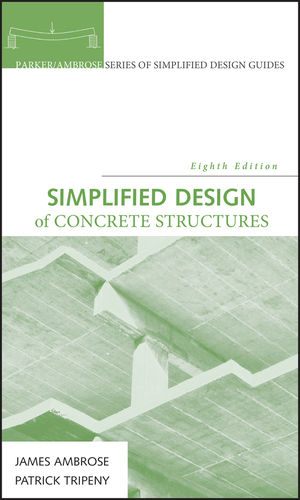Simplified Design of Concrete Structures, 8th EditionISBN: 978-0-470-04414-8
Hardcover
448 pages
January 2007
 |
||||||
Preface to the Eighth Edition xi
Preface to the First Edition xv
Introduction 1
1 Structural Use of Concrete 10
1.1 Concrete as a Structural Material 10
1.2 Common Forms of Concrete Structures 11
1.3 Primary Situations for Investigation and Design 13
1.4 Materials and Nature of Structural Concrete 14
1.5 Significant Properties of Concrete 18
1.6 Reinforcement 22
1.7 Prestressed Concrete 26
1.8 Design of Concrete Mixes 30
1.9 Special Concretes 31
2 Considerations for Production of Concrete 33
2.1 General Concerns for Concrete 33
2.2 Concerns for Structural Concrete 34
2.3 Sitecast Concrete 35
2.4 Design and Production Controls 38
2.5 Inspection and Testing 39
2.6 Installation of Reinforcement 41
2.7 Precast Concrete 42
2.8 Mixed Systems: Sitecast and Precast 47
2.9 Concrete Masonry 48
3 General Requirements for Reinforced Concrete Structures 50
3.1 Code and Industry Standards 50
3.2 Practical Considerations 51
3.3 Control of Cracking 55
3.4 General Requirements for Steel Reinforcement 56
4 Investigation and Design of Reinforced Concrete 59
4.1 Situations for Investigation and Design 59
4.2 Methods of Investigation and Design 61
4.3 The Stress Method 62
4.4 The Strength Method 62
4.5 Investigation of Columns and Beams 63
4.6 Investigation of Column and Beam Frames 72
4.7 Approximate Investigation of Indeterminate Structures 78
5 Load and Resistance Factor Design (LRFD) 83
5.1 Limit States Versus Service Conditions 83
5.2 Loads for Design 84
5.3 Resistance Factors 85
5.4 Strength Design Processes 86
6 Reinforced Concrete Flexural Members 87
6.1 General Flexural Actions 87
6.2 Behavior of Reinforced Concrete Beams 88
6.3 Investigation and Design for Flexure 90
6.4 Beams in Sitecast Systems 101
6.5 T-Beams 104
6.6 Beams with Compression Reinforcement 110
6.7 Spanning Slabs 117
6.8 Deflection Control 122
7 Shear in Concrete Structures 125
7.1 General Concerns for Shear 125
7.2 Shear in Beams 126
7.3 Shear Reinforcement for Beams 127
7.4 Design for Beam Shear 133
8 Anchorage and Development of Reinforcement 142
8.1 Development of Stress in Tension Reinforcement 143
8.2 Hooks 146
8.3 Bar Development in Continuous Beams 148
8.4 Splices in Reinforcement 149
8.5 Development of Compressive Reinforcement 150
8.6 Developed Anchorage for Frame Continuity 153
9 Flat-Spanning Concrete Systems 154
9.1 Slab and Beam Systems 155
9.2 General Considerations for Beams 162
9.3 Other Flat-Spanning Systems 167
9.4 Design Aids 178
10 Concrete Columns 180
10.1 Effects of Compression Force 180
10.2 Reinforcement for Columns 182
10.3 Types of Columns 184
10.4 General Requirements for Columns 186
10.5 Combined Compression and Bending 187
10.6 Considerations for Column Shape 189
10.7 Columns in Sitecast Frames 191
10.8 Multistory Columns 192
10.9 Design Methods and Aids 194
10.10 Approximate Design of Tied Columns 195
10.11 Round Columns 202
10.12 Special Concerns for Concrete Columns 204
10.13 Vertical Concrete Compression Elements 205
10.14 Concrete Masonry Columns and Piers 208
11 Column and Beam Frames 210
11.1 Two-Dimensional Frames 211
11.2 Three-Dimensional Frames 212
11.3 Mixed Frame and Wall Systems 214
11.4 Special Problems of Concrete Framed Bents 217
12 Concrete Walls 221
12.1 Sitecast Walls: General Concerns 221
12.2 Concrete Bearing Walls 223
12.3 Concrete Basement Walls 226
12.4 Concrete Shear Walls 230
12.5 Precast Concrete Walls 230
12.6 Concrete Masonry Walls 231
13 Foundations 233
13.1 General Concerns for Foundations 234
13.2 Soil Conditions Related to Foundation Design 235
13.3 Foundation Design: Criteria and Process 237
13.4 Shallow Bearing Foundations 238
13.5 Wall Footings 240
13.6 Column Footings 249
13.7 Special Column Footings 258
13.8 Pedestals 259
13.9 Foundation Walls and Grade Beams 266
13.10 Deep Foundations 270
14 Miscellaneous Concrete Structures 277
14.1 Paving Slabs 277
14.2 Framed Floors on Grade 280
14.3 Cantilever Retaining Walls 281
14.4 Abutments 291
15 General Considerations for Building Structures 296
15.1 Choice of Building Construction 296
15.2 Structural Design Standards 297
15.3 Loads for Structural Design 298
15.4 Dead Loads 298
15.5 Building Code Requirements for Structures 301
15.6 Live Loads 303
15.7 Lateral Loads (Wind and Earthquake) 306
15.8 Load Combinations 310
15.9 Determination of Design Loads 310
15.10 Structural Planning 312
15.11 Building Systems Integration 313
15.12 Economics 313
16 Building Structures: Design Examples 316
16.1 Building One: General Considerations 317
16.2 Building One: Support and Site Structures 317
16.3 Building Two: General Considerations 326
16.4 Building Two: Design for Gravity Loads 326
16.5 Building Two: Design for Lateral Loads 329
16.6 Building Two: Alternative Structure 340
16.7 Building Three: Alternative Structure One 341
16.8 Building Three: Alternative Structure Two 344
16.9 Building Three: Alternative Structure Three 348
16.10 Building Four: General Considerations 349
16.11 Building Four: Concrete and Masonry Structure 353
16.12 Building Four: Design for Lateral Loads 359
16.13 Building Four: All-Concrete Structure 361
16.14 Building Five: General Considerations 364
16.15 Building Five: Masonry and Frame Structure 368
16.16 Building Five: The Concrete Structure 374
16.17 Building Five: Alternative Floor Structure 398
Glossary 401
Study Aids 405
Terms 405
Questions 408
Answers to Questions 411
Answers to Exercise Problems 415
References 419
Index 421



